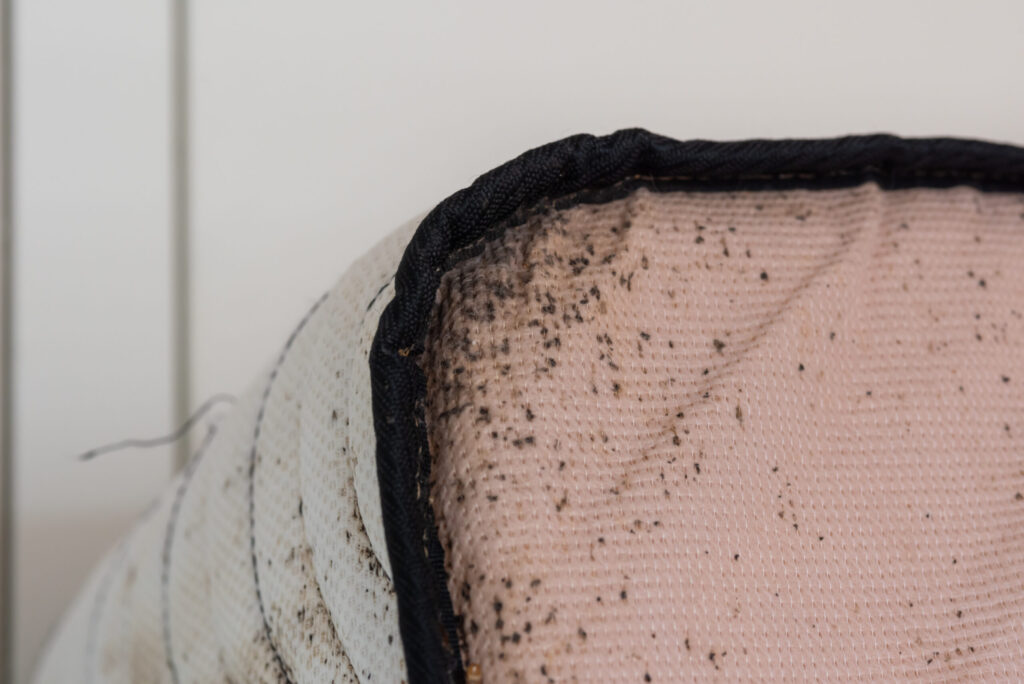Introducing the Concern: Understanding the Fear of Bed Bugs
Can You Sleep in Your Bed After Bed Bug Treatment? Bed bugs are more than mere annoyances; they symbolize a disruption in the sanctuary of our homes and, more specifically, our bedrooms. The sight of a bed bug, or even the thought of one, can send chills down the spine of any homeowner. They are elusive creatures that hide in the nooks and crannies of our beds, furniture, and even clothing, making them notoriously difficult to eradicate. A bed bug infestation can lead to sleepless nights, incessant itching, and a profound sense of discomfort.
The Importance of Bed Bug Treatment
Restoring peace and comfort in one’s living space hinges on swiftly and effectively addressing a bed bug infestation. Bed bug treatments aim to pinpoint these pests at every life cycle stage, from eggs to adults. According to the Environmental Protection Agency (EPA), bed bugs can endure for several months without a meal and researchers have documented their survival in diverse environments, showcasing their remarkable resilience. The appropriate treatment not only eliminates prevailing infestations but also aids in thwarting potential future outbreaks. You can read more about this information on the EPA’s Official Website.
Overview of What the Post Will Cover
In this comprehensive guide, we will delve into whether you can sleep in your bed after bed bug treatment. Understanding the types of treatments available, the process of post-treatment care, the safety measures you should take, and hearing real-life stories will empower you to make informed decisions. By the time you finish reading this article, you will have a clear understanding of what to expect after bed bug treatment and how to ensure a restful, bed bug-free sleep.
Understanding Bed Bug Treatment: Types of Bed Bug Treatments
Bed bugs, with their knack for survival, necessitate a well-thought-out approach to treatment. Depending on the severity and location of the infestation, there are several types of bed bug treatments to consider:

- Chemical Treatments: These treatments utilize specialized insecticides designed to target bed bugs. They must be applied by trained professionals to ensure effectiveness and safety.
- Heat Treatments: By raising the temperature in the infested area to levels that bed bugs cannot survive; heat treatments offer a non-toxic solution. They are often used in conjunction with other methods for maximum impact.
- Non-Chemical Methods: This category includes physical measures such as vacuuming, steaming, or using traps. Non-chemical methods are often preferred for their eco-friendly nature but may require repeated applications.
How Treatment Works on Bed Bugs
The treatment’s success hinges on understanding the biology and behavior of bed bugs. According to a study from Entomology Today, advancements in bed bug control have led to innovative approaches like heat treatments combined with insecticides. These techniques focus on reaching bed bugs in their hiding spots and disrupting their life cycle, from eggs to mature adults. Attention to detail and adherence to professional guidelines ensures that the treatment is thorough and lasting.
Professional vs. DIY Treatment
Choosing between professional extermination and do-it-yourself methods is a decision that must be taken with great care. While DIY treatments may seem cost-effective, they often lack the precision and effectiveness of professional intervention. Engaging a reputable bed bug extermination service ensures that the treatment is tailored to your specific situation, conducted safely, and brings lasting results.
Can You Sleep in Your Bed Immediately After Treatment?
General Recommendations
The lingering question on many minds after a bed bug treatment is whether it’s safe to sleep in the bed right away. Generally, the answer depends on the type of treatment applied and the instructions given by the pest control professionals. Some treatments may allow immediate occupancy, while others might require a waiting period. Adhering to professional advice is crucial to ensuring a safe and comfortable return to your bed.
Possible Risks and Concerns
Ignoring the guidelines provided after bed bug treatment can lead to several risks. There may be residual chemicals from insecticide treatments that need time to dissipate. The area might need proper ventilation post-treatment, especially if heat or chemical methods were used. According to the National Pesticide Information Center, failing to follow post-treatment instructions can lead to ineffectiveness of the treatment and potential health risks.
Safety Measures and Precautions
Adopting the right safety measures post-treatment is paramount for a bed bug-free environment. Some essential steps include:
- Following Professional Guidelines: Heeding the instructions provided by the exterminators ensures the effectiveness of the treatment.
- Monitoring the Treated Areas: Regular inspection for any signs of bed bugs helps in early detection of a resurgence.
- Proper Ventilation and Cleaning: Allowing fresh air and conducting thorough cleaning as advised by professionals will make the sleeping environment safe and comfortable.
Post-Treatment Care: Preparing the Room
After bed bug treatment, the room requires careful preparation to ensure a return to normalcy. This process might involve:
- Removing Protective Coverings: Many professionals will cover certain items to protect them during treatment. These should be removed as instructed.
- Inspecting Furniture and Belongings: Check for any signs of remaining bed bugs or damage from the treatment itself.
- Repositioning Items: Carefully replace any moved furniture or belongings, making sure not to disrupt any treated areas.
Cleaning and Maintenance after Bed Bug Treatment
Thorough cleaning and ongoing maintenance are vital in maintaining a bed bug-free environment. Here are the steps to consider:
- Following Cleaning Instructions: Adhering to specific guidelines provided by the pest control professionals for cleaning surfaces, fabrics, and other areas.
- Regular Vacuuming and Steaming: Keeping the treated areas clean by using methods that deter bed bugs from returning.
- Utilizing Protective Encasements: Using bed bug-proof encasements on mattresses and pillows can add an extra layer of security.
Monitoring for Remaining Bed Bugs
Vigilance in monitoring for any signs of remaining bed bugs is key. As advised by experts from the Centers for Disease Control and Prevention (CDC), continuous monitoring can help in detecting and dealing with any residual bed bugs. Steps include:

- Regular Inspections: Routinely check for any signs of bed bugs in bedding, furniture, and other hiding spots.
- Using Traps or Monitors: Devices designed to trap bed bugs can be placed in strategic locations for ongoing monitoring.
- Engaging Periodic Professional Inspections: Having professionals revisit the site periodically ensures that the treatment remains effective.
Real-Life Stories: Insights from Those Who Have Experienced Bed Bug Treatments
Success Stories: Triumph Over Bed Bugs
Many individuals have successfully reclaimed their homes and peace of mind after a bed bug treatment. These stories highlight the effectiveness of professional interventions, adherence to post-treatment guidelines, and the importance of vigilance. Such success stories can serve as inspiration and affirmation that bed bug problems can indeed be resolved.
Challenges Faced: The Importance of Following Instructions
While many have succeeded in eradicating bed bugs, others have faced challenges due to misunderstandings, lack of adherence to professional instructions, or choosing inappropriate DIY methods. An article published by the New York Times highlights the resurgence of bed bugs in various settings, underscoring the importance of following professional guidelines and monitoring.
The Emotional Impact of Bed Bug Infestations:
The journey of dealing with bed bugs goes beyond the physical challenges; it often involves an emotional toll. Individuals have reported feelings of anxiety, embarrassment, or frustration during and after the infestation. Understanding this aspect humanizes the problem and makes readers aware that they are not alone in their emotions.
Learning from Others: Key Takeaways
Real-life experiences provide invaluable lessons. Key takeaways from these stories include:
- Trust in Professionals: Engaging qualified exterminators and following their instructions can lead to a successful outcome.
- Consistent Monitoring: Regular inspections and vigilance post-treatment prevent recurrence.
- Emotional Support: Seeking support from friends or professionals can alleviate the stress associated with bed bugs.
Conclusion: Achieving Peace of Mind After Bed Bug Treatment
Dealing with bed bugs is a complex and often stressful challenge that requires careful consideration, professional intervention, and diligent follow-up. This comprehensive guide has explored various facets of the question, “Can you sleep in your bed after bed bug treatment?”
Understanding the Treatment Process: From chemical to heat treatments, understanding the various methods available and how they work on bed bugs is foundational to success.
Assessing Safety and Risks: Knowing when and how to safely return to your bed post-treatment, as supported by reputable sources like the National Pesticide Information Center, is crucial for both effectiveness and well-being.
Post-Treatment Care and Vigilance: Following professional guidelines for cleaning, monitoring, and ongoing maintenance ensures a lasting solution to bed bug problems.
Gleaning Insights from Real Experiences: Real-life stories and insights, such as those highlighted by the New York Times, offer valuable lessons and emotional perspectives on dealing with bed bugs.
Bed bug infestations are undoubtedly distressing, but with the right approach, professional guidance, and personal commitment, they can be effectively managed. By equipping readers with detailed knowledge, actionable insights, and empathetic understanding, this blog post aims to empower individuals facing bed bug issues to take control of their situation.
The journey towards a bed bug-free life is achievable, and this guide serves as a comprehensive roadmap. If followed diligently, readers can expect to not only resolve their bed bug issue but also regain the peace and comfort of their living spaces. It is a testament to the resilience, innovation, and shared human experience that defines our approach to such persistent challenges.




